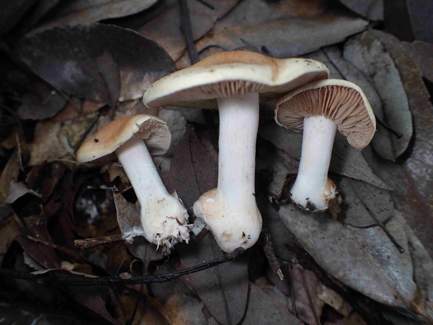 Hebeloma citrisporum (Photo: U. Kawasaki)
Hebeloma citrisporum (Photo: U. Kawasaki)Taxonomy
Full name: Hebeloma citrisporum Beker & U. Eberh., Mycol. Prog. 21: 465 (2022)Genus: Hebeloma
Section: Velutipes
Types: JAPAN: Ibaraki, Tsukuba, Ibaragi (approx. 36.0869°N, 140.1197°E, alt. approx. 30 m a.s.l.) in urban roadside pondside under Quercus myrsinifolia and Quercus serrata, 24 Oct. 2016, U. Kawasaki (270) (Holotype. herbarium acc. no. BR5020214140236V, MUOB 258729, HJB15833).
- arrow_drop_downarrow_drop_upEtymologyFrom citrus (noun, Latin) meaning lemon, lemon tree and spora (Latin) to emphasize the limoniform spores.
- arrow_drop_downarrow_drop_upDiagnosisThe citriformspores, distinctly ornamented and rather strongly dextrinoid but with the perispore only somewhat loosening in a few spores, with average width less than 7.5 μm, and the predominantly gently clavate cheilocystidia with average width near the apex greater than 6.5 μm and average ratio of basal width to median width (B/M) at most 1.35, distinguish this species fromother Hebeloma.
References
Description
- arrow_drop_downarrow_drop_upThresholds
Description of Hebeloma citrisporum based on 5 collections
- arrow_drop_downarrow_drop_upMacroscopic descriptionPileus: (21) 28–63 (68) mm diameter; shape often umbonate, occasionally convex or broadly umbonate; characters spotting; margin characters usually smooth, occasionally involute or wavy; viscosity tacky when moist; colour variation two color; colour at centre yellowish brown.
Lamellae: attachment emarginate; maximum depth not recorded; number of complete lamellae 52–64; presence of tears absent; white fimbriate edge present.
Cortina presence: no.
Stipe: (22) 31–64 (84) x (6) 7–9 (10) {median} x 10–14 (18) {basal} mm; stipe Q 3.1–12.0; base shape bulbous; floccosity usually pruinose at apex, often velute, occasionally fibrillose or floccose at apex; rooting no; thick rhizoids at base present;
Context: Texture firm; stipe interior Not recorded; stipe flesh discolouring no; slenderness measure 4.3–18.7; smell Not recorded; taste Not recorded.
Spore deposit colour: Not recorded.
Exsiccata characters: Not recorded.
- arrow_drop_downarrow_drop_upMicroscopic descriptionSpores: shape amygdaloid or limoniform; colour in microscope often yellow or yellow brown, occasionally yellow pale; guttules often yes, occasionally no. papilla very strongly; Spore Code: O2 O3; P1 (P2); D3.
Basidia: (25) 26–36 x 7–9 (10) μm; ave. Q 3.4–3.6; spore arrangement 4 spored;
Cheilocystidia: main shape gently clavate, clavate-lageniform or clavate-ventricose or ventricose; special features observed often septa; cheilocystidia ratios: A/M = 1.31–1.58; A/B = 1.09–1.38; B/M = 1.12–1.35.
Pleurocystidia: none seen.
Ixocutis: epicutis thickness (measured from exsiccata) up to 115 μm; ixocutis hyphae width up to 7 μm; ixocutis hyphae encrustation yes; shape of trama elements beneath subcutis thickly sausage-shaped, often cylindrical up to 18 μm wide.
Caulocystidia: Similar to cheilocystidia but larger, up to 135 μm.
- arrow_drop_downarrow_drop_upSpore measurements
- arrow_drop_downarrow_drop_upCheilocystidia measurements
- arrow_drop_downarrow_drop_upHabitat and distributionAcross our collections, Hebeloma citrisporum has only been recorded as associating with Quercus (family Fagaceae). The growth habit of our collections was scattered and occasionally caespitose.
According to our current collections, the species is found only in Asia-Temperate. On the continent, collections have been found only in the Taiheiyo evergreen forests WWF ecoregion The World Wildlife Fund (WWF) have divided the world into 867 terrestrial ecoregions. The ecoregion here is estimated by mapping from the GPS coordinates of the collection using data made available by Dinerstein et al (2017). Use this webtool to explore the ecoregions visually or see a full list of current ecoregions on Wikipedia. (temperate broadleaf & mixed forests biome). From collector information, it appears collections have been found in the 14.5 Urban Areas (66.7%) and 1.4 Forest – Temperate (33.3%) IUCN habitats We map from the collector's description of the habitat to the International Union for Conservation of Nature (IUCN)'s definition using a standardised set of rules. Please see this page for a full list of IUCN habitats.. Within Temperate Asia all our records are from Eastern Asia (Japan).
- arrow_drop_downarrow_drop_upCommentaryThe predominantly gently clavate towards the apex cheilocystidia, with a few ventricose or clavateventricose, supports the placement of H. citrisporum in H. sect. Velutipes. Within this section, the citriform spores, distinctly ornamented and rather strongly dextrinoid but with the perispore only somewhat loosening in a few spores, with average width less than 7.5 μm, and the cheilocystidia with average width near the apex greater than 6.5 μm and average ratio of basal width to median width (B/M) at most 1.35, distinguish this species. While citriform spores are commonly found within species of H. sect. Velutipes, rarely are they as regular and eyecatching as for this species. The species and its placement in H. sect. Velutipes are supported by molecular data (Eberhardt et al. 2022). The description is based on just five collections from a relatively small geographic area around Tokyo. We would suspect that it is far more widespread, at least on Honshu Island. A Quercus dentata root tip sequence from Hokkaido (AB979728, Arai et al. 2017) might have been formed by H. citrisporum. Currently (9 June 2021), the sequence forms a singleton UNITE SH (SH1235508.08FU) at the 3% level. It differs from our H. citrisporum sequences by three indels, two singleton deletions and one 15 bp insertion which we have not observed in our material. Japanese name: Tokiwa-wakafusa-take (Eberhardt et al. 2022).
Geographic distribution
Phenology
- arrow_drop_downarrow_drop_upAdditional cited collections